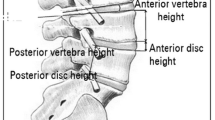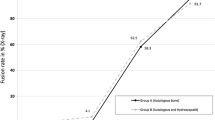Abstract
Purpose
The purpose of this study is to compare bone union rate between autologous iliac bone and local bone graft in patients treated by posterior lumbar interbody fusion (PLIF) using carbon cage for single level interbody fusion.
Methods
The subjects were 106 patients whose course could be observed for at least 2 years. The diagnosis was lumbar spinal canal stenosis in 46 patients, herniated lumbar disk in 12 patients and degenerative spondylolisthesis in 51 patients. Single interbody PLIF was done using iliac bone graft in 53 patients and local bone graft in 56 patients. Existence of pseudo-arthrosis on X-P (AP and lateral view) was investigated during the same follow up period.
Results
No significant differences were found in operation time and blood loss. Significant differences were also not observed in fusion grade at any follow up period or in fusion progression between the two groups. Donor site pain continued for more than 3 months in five cases (9 %). The final fusion rate was 96.3 versus 98.3 %.
Conclusions
Almost the same results in fusion were obtained from both the local bone group and the autologous iliac bone group. Fusion progression was almost the same. Complications at donor sites were seen in 19 % of the cases. From the above results, it was concluded that local bone graft is as beneficial as autologous iliac bone graft for PLIF at a single level.



Similar content being viewed by others
References
An HS, Lynch K, Toth J (1995) Prospective comparison of autograft vs. allograft for adult posterolateral lumbar spine fusion: differences among freeze-dried, frozen, and mixed grafts. J Spinal Disord 8:131–135
Le Huec JC, Lesprit E, Delavigne C et al (1997) Tri-calcium phosphate ceramics and allografts as bone substitutes for spinal fusion in idiopathic scoliosis: comparative clinical results at four years. Acta Orthop Belg 63:202–211
Frenkel SR, Moskovich R, Spivak J et al (1993) Demineralized bone matrix. Enhancement of spinal fusion. Spine 18:1634–1639
Holliger EH, Trawick RH, Boden SD et al (1996) Morphology of the lumbar intertransverse process fusion mass in the rabbit model: a comparison between two bone graft materials-rhBMP-2 and autograft. J Spinal Disord 9:125–128
Tay BK, Le AX, Heilman M et al (1998) Use of a collagen-hydroxyapatite matrix in spinal fusion. A rabbit model. Spine 23:2276–2281
Younger EM, Chapman MW (1989) Morbidity at bone graft donor sites. J Orthop Trauma 3:192–195
Keller EE, Triplett WW (1987) Iliac bone grafting: review of 160 consecutive cases. J Oral Maxillofac Surg 45:11–14
Summers BN, Eisenstein SM (1989) Donor site pain from the ilium: a complication of lumbar spine fusion. J Bone Joint Surg Br 71:677–680
Violas P, Chapuis M, Bracq H (2004) Local autograft bone in the surgical management of adolescent idiopathic scoliosis. Spine 29:189–192
Miura Y, Imagama S, Yoda M et al (2003) Is local bone viable as a source of bone graft in posterior lumbar interbody fusion? Spine 28:2386–2389
Hashimoto T, Oha F, Shigenobu K et al (2001) Mid-term clinical results of Graf stabilization for lumbar degenerative pathologies: a minimum 2-year follow-up. Spine J 1:283–289
Tsuchiya K, Bridwell KH, Kuklo TR et al (2006) Minimum 5-year analysis of L5-S1 fusion using sacropelvic fixation (bilateral S1 and iliac screws) for spinal deformity. Spine 31(3):303–308
Ito Z, Matsuyama Y, Sakai Y et al (2010) Bone union rate with autologous iliac bone versus local bone graft in posterior lumbar interbody fusion. Spine 35(21):E1101–E1105
Brantigan JW, Steffee AD, Lewis ML et al (2000) Lumbar interbody fusion using the Brantigan I/F cage for posterior lumbar interbody fusion and the variable pedicle screw placement system: two-year results from a Food and Drug Administration investigational device exemption clinical trial. Spine 25:1437–1446
Agazzi S, Reverdin A, May D (1999) Posterior lumbar interbody fusion with cages: an independent review of 71 cases. J Neurosurg 91:186–192
Christensen FB, Hansen ES, Eiskjaer SP et al (2002) Circumferential lumbar spinal fusion with Brantigan cage versus posterolateral fusion with titanium Cotrel-Dubousset instrumentation: a prospective, randomized clinical study of 146 patients. Spine 27:2674–2683
Hashimoto T, Shigenobu K, Kanayama M et al (2002) Clinical results of single-level posterior lumbar interbody fusion using the Brantigan I/F carbon cage filled with a mixture of local morselized bone and bioactive ceramic granules. Spine 27:258–262
Kim KS, Ki YT, Lee JC (2005) Radiological changes in the bone fusion site after posterior lumbar interbody fusion using carbon cages impacted with laminar bone chips: follow-up study over more than 4 years. Spine 30:655–660
Diedrich O, Perlick L, Schmitt O et al (2001) Radiographic characteristics on conventional radiographs after posterior lumbar interbody fusion: comparative study between radiotranslucent and radiopaque cages. J Spinal Disord 14:522–532
Banwart JC, Asher MA, Hassanein RS (1995) Iliac crest bone graft harvest donor site morbidity: a statistical evaluation. Spine 20:1055–1060
Robertson PA, Wray AC (2001) Natural history of posterior iliac crest bone graft donation for spinal surgery: a prospective analysis of morbidity. Spine 26:1473–1476
Sengupta DK, Truumees E, Patel CK et al (2006) Outcome of local bone versus autogenous iliac crest bone graft in the instrumented posterolateral fusion of the lumbar spine. Spine 31:985–991
Conflict of interest
None.
Author information
Authors and Affiliations
Corresponding author
Rights and permissions
About this article
Cite this article
Ito, Z., Imagama, S., Kanemura, T. et al. Bone union rate with autologous iliac bone versus local bone graft in posterior lumbar interbody fusion (PLIF): a multicenter study. Eur Spine J 22, 1158–1163 (2013). https://doi.org/10.1007/s00586-012-2593-4
Received:
Revised:
Accepted:
Published:
Issue Date:
DOI: https://doi.org/10.1007/s00586-012-2593-4




